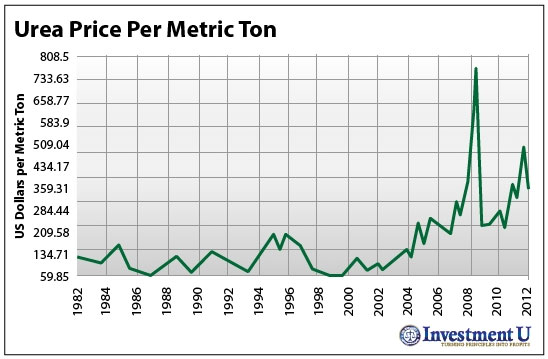by Ryan Fitzwater, Investment U Research
Friday, February 17, 2012

The world has a rapidly growing problem on its hands: an exponentially increasing human population.
In 1960, the world population was three billion. Last year, it reached seven billion, and in 2040, the United Nations expects it to be around nine billion.
The organization noted in a recent report that the globe is running out of time to ensure that there?s enough water, energy and food for the rising population, as each year we?ll have more mouths to feed.
And the U.N. warns that if the world is unsuccessful in tackling these problems, it could send three billion people into poverty.
The Seeds for a Commodity Supercycle
According to U.N. estimates, by 2030 the globe will need at least 50% more food. And in a rapidly changing environment, new limits to supply will be created, and demand for food will rise exponentially, creating what experts call a commodity supercycle.
The current commodity supercycle, which is pushing food prices even higher, started back in 2000.
Commodity experts, like Jim Rogers, have expressed a belief that the current commodity supercycle will last for 20 to 25 years.
Chris Watling of Longview Economics agrees. Watling is the one who identified that commodity bull rallies last 20 to 25 years, tracing secular bull markets back to 1750.
And if Rodgers and Watling are correct, then the commodity bull market that started in 2000 will run all the way until 2020 to 2025.
Simple Equation: More Food = More Fertilizer
Rodgers himself has noted that there is currently a powerful underlying demand for food.
In 2007, food prices surged, sending millions into starvation and causing riots in Cameroon, Egypt, Bangladesh and Haiti. And while food prices dropped in 2008, cooling the riots, they?ve been rising since 2009.
And Rodgers sees ?more turmoil? in the future.
As the world population has more than doubled in the past 50 years and continues to grow, food shortages are set to rise while the quantity of arable farmland is decreasing.
But the growing global food crisis isn?t all doom and gloom? it offers an opportunity for innovators in the agricultural industry, especially for those who produce fertilizers.
It?s simple; growing demand for food will bring an increased demand for fertilizers.
Just take a look at some key information provided by The International Fertilizer Association below:
- Every year the world uses 170 million tons of fertilizer for food, fiber, fuel and feed.
- ?Global food security? and ?sustainable agriculture? will continue to become popular phrases in our vocabulary.
- Nitrogen fertilizers are used to produce 48% of the world?s food.
- Without the use of fertilizer, two billion more people will likely become vulnerable to hunger.
Indicators point to an extreme need for increases in crop and fertilizer production, which is good news for companies like CF Industries Holdings (NYSE: CF) and Scotts Miracle-Gro Company (NYSE: SMG).
While both produce fertilizer for the agriculture industry, out of these two players I like CF Industries the best. The company currently has an attractive P/E of 9.67, much lower than the industry average of 14 and half the size Scotts Miracles-Gro?s P/E, currently sitting at 19.74.
There?s also the big guys like Potash Corporation of Saskatchewan (NYSE: POT) and The Mosaic Company (NYSE: MOS). Even the miners, such as Vale S.A. (NYSE: VALE), which mine the potash used as fertilizer.
But at Investment U, we like to uncover new ideas so that our readers are the first to know. And there?s one new startup that?s trying to revolutionize the way farmers fertilize their crops?
But before we take a look at that small company, I?ll need to cover some details on the specific fertilizer they produce called ?urea.?
Quick Guide to Urea
First discovered by French chemist Hilare Marin Rouelle in 1773, urea became the first organic compound to be synthetically formulated in 1828 by a pioneer of organic chemistry, German chemist Friedrich Wohler.
I won?t bore you with the science behind how urea makes soil more fertile for crops (where soil bacteria can posses the enzyme ?unrease,? which converts urea into ammonia form in soil, etc.), but I will highlight some interesting data that makes it such an attractive product for agricultural producers.
Urea is an exceptional fertilizer; it?s extremely soluble in water, non-toxic, easy to manufacture and can be used on all types of crops.
And while urea is an important raw material for the chemical industry and is also used in the medical field, explosives and some automotive systems, more than 90% of urea world production is for use as a nitrogen-release fertilizer.
Urea has the highest nitrogen content of all commonly used solid nitrogenous fertilizers, 46%. And it makes up 57.4% of worldwide nitrogen fertilizer consumption, according to the IFA.
Compared to other nitrogen fertilizers, urea is safer to transport, less corrosive to equipment and has the lowest transport cost per unit of nitrogen nutrient.
And as the major fertilizer traded internationally, urea has captured more than 56% of world trade in the dry fertilizer category to date.

Prices for urea have gradually increased over time, and are up over 360% since the beginning of 2000, costing around $368.38 per metric ton today. And prices will continue to rise as demand increases.
A New Business Model
And the small startup that could profit from increasing demand for urea fertilizers is BioNitrogen Corp. (OTC: BION.PK).
Based in Doral, Florida, BioNitrogen is a company that can produce urea fertilizer using a method that?s environmentally responsible and helpful to local economies.
More than 90% of the world?s urea production uses natural gas as the hydrocarbon feedstock. As we know, using natural gas creates carbon dioxide as a byproduct, which has a negative effect on the environment.
This is where BioNitrogen has separated itself from the competition.
The company has created an innovative business model using an inexpensive, small-scale technology that gasifies biomass and transforms the resulting natural gas into urea.
Put more simply, BioNitrogen has created a process that takes municipal and agricultural waste (rice and peanut hulls, corn stalks and leaves, sugar cane remains, etc., which have little or no value), and burns it in a contained system to create synthetic natural gas and produce urea.
Agricultural waste is renewable and doesn?t require the need to pull fossil fuels from the earth. And the company?s manufacturing method recycles harmful chemicals separated during the urea creation process, creating a production scheme that has virtually no impact on the environment.
It isn?t just a fresh advanced technology that puts BioNitrogen in a new generation of fertilizer producers, it?s their local based business model that makes it possible.
They build small, cost-effective plants where the raw materials exist (farmers biomass), take it, transport it at a low cost, convert it into urea and sell it right back to the farmers.
The plants are greenhouse gas free, use 100% recycled water and send excess electricity they generate right back to the gird.
Providing a small scale, localized production model has its advantages, including lower costs for material handling, transportation and land acquisition.
Future Growth
Management understands the demand that population growth will bring to fertilizers and believes that the market for urea is strong.
Michael McCarthy, the company?s Chief Financial Officer, recently stated in an address to the Advisory Board of BioNitrogen:
?The world?s population will always need more food no matter the economic conditions of most of the global economies or countries. In our view, BioNitrogen?s proprietary production facilities will quickly become the gold standard for exceeding environmental compliance. From a company valuation and investment perspective, BioNitrogen?s strategic market positioning is very strong indeed.?
And while I agree that BioNitrogen has a great business model that could see substantial growth in the future, investors should use caution, as this is a story we hope will turn into a profitable endeavor for shareholders.
The stock started trading publicly at the end of January and has not filed a quarterly report yet, so we cannot verify the health of the company?s finances. Also, with such a cheap stock with low volume, the price swings can be incredibly volatile.
That being said, BioNitrogen is certainly something investors should keep their eye on. As we continue to see the world population grow and the demand for food and fertilizers grow with it, companies like BioNitrogen will have the opportunity to thrive.
Good Investing,
Ryan Fitzwater
Any investment contains risk. Please see our disclaimerRelated Investment U Articles:
Comments
**By submitting your comment you agree to adhere to our Comment Policy and Privacy Policy.Source: http://www.investmentu.com/2012/February/investing-in-agriculture.html
crimson tide dixville notch 2013 ford fusion lsu football lsu football bcs jay z glory
No comments:
Post a Comment
Note: Only a member of this blog may post a comment.